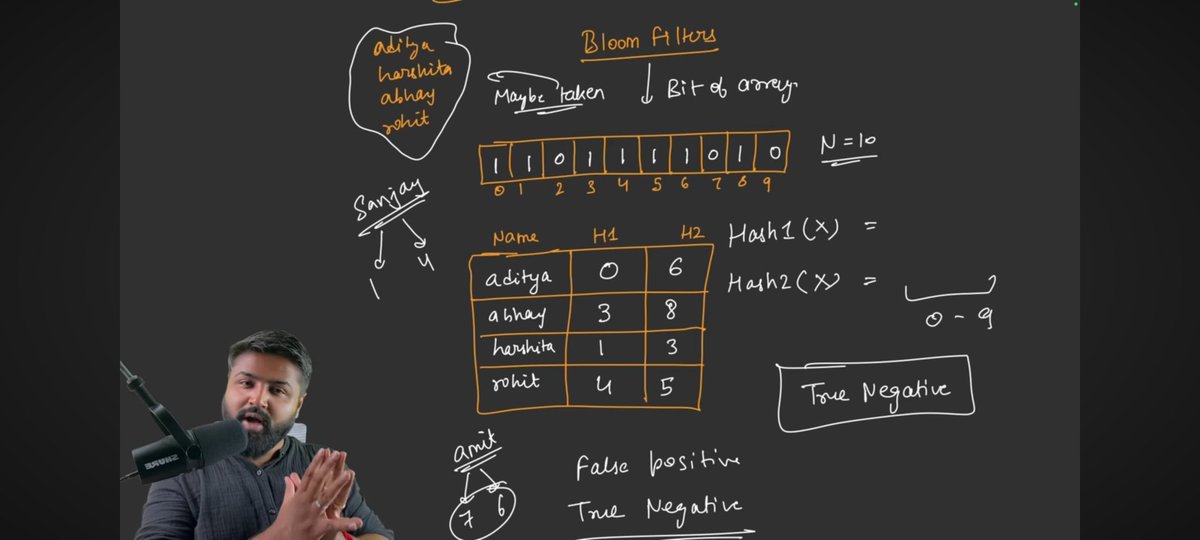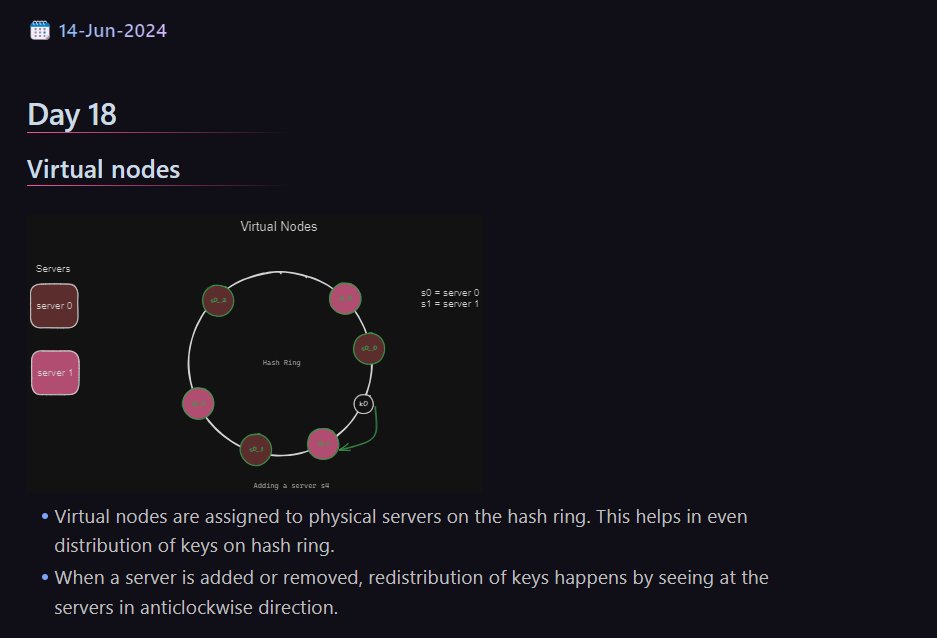#100daysofsystemdesign search results
Day 11: Functional vs Non-Functional Requirements In system design, requirements shape EVERYTHING. But not all requirements are equal... Let’s break it down ⬇️ #Day11 #100DaysOfSystemDesign #technofanart #SystemDesign
🚀Bloom Filter✨ A probabilistic data structure using hash functions and arrays of bits ✅ Space-efficient ✅ Allows false positives, never false negatives Perfect for developers exploring large-scale system design #CodingChallenge #100DaysOfSystemDesign #LLD #100DaysOfCode

🔹 Structured Design (SD): Design the solution 🏗️ Structure Charts ✍️ Pseudocode Together = clear, maintainable systems ✅ #100DaysOfSystemDesign
Day 8 of my #SystemDesign journey! Today I learned about Functional Requirements — the "what" of a system, not the "how". Think of them as a checklist of features your system MUST deliver ✅ #100DaysOfSystemDesign #Tech
🧠 Today I studied: 1️⃣ Unique ID Generators – UUIDs, Twitter Snowflake, and strategies for generating scalable, ordered IDs in distributed systems 2️⃣ URL Shorteners – base62 encoding, hash collisions, DB schema #LearnInPublic #Backend #100DaysOfSystemDesign

Day 7 of my #SystemDesign journey! Today I explored the System Design Life Cycle (SDLC) — the backbone of building scalable systems. Think of it as a recipe for software success 👇 #100DaysOfSystemDesign #Tech
🚀 Day 6 of my System Design Journey! (Thanks to @rohit_negi9 & @adityatandon02 🙌). 🧠 Today’s highlights: SOLID Design Principles: 1) Interface Segregation Principle 2) Dependency Inversion Principle Let’s build systems like pros 💻🔥 #SystemDesign #100DaysOfSystemDesign

Day 6: System Design Strategies Good system design = clarity, scalability & maintainability It’s all about organizing modules so they’re easy to develop, debug & change. Key Goal: Create a blueprint that balances efficiency + adaptability. #Day6 #100DaysOfSystemDesign
Day 2/100: Starting #100DaysOfSystemDesign! 🚀 Ever wondered why 99.999% ("five nines") availability allows ~5 mins downtime/year, while 99% means 3.65 days? Let’s unpack reliability & design essentials. Thread 🧵👇 #SystemDesign

Day 9 of my #SystemDesign Journey Today I explored OOAD (Object-Oriented Analysis & Design) It’s all about thinking of software as objects—just like real-world entities. Why? Makes systems easier to reuse, manage & scale. #100DaysOfSystemDesign #Tech
🔹 Structured Analysis (SA): Understand the problem 📊 Data Flow Diagrams (DFD) 📖 Data Dictionary 🔄 State Transition Diagrams 🗂️ ER Diagrams #100DaysOfSystemDesign
Day 14 of my #SystemDesign Journey Today I explored the battle of methodologies → 👉 Structured Analysis ⚙️ vs. Object-Oriented Analysis (OOA) 🧩 Both help design systems, but they think very differently. Let’s break it down ⬇️ #Day14 #100DaysOfSystemDesign #TechTwitter
Day 10: System Design Journey Today I explored Non-Functional Requirements (NFRs) – the unsung heroes of system design. If functional reqs say “what the system does” → NFRs define “how well it does it”. 🏗️✨ A quick thread 🧵 #Day10 #SystemDesign #100DaysOfSystemDesign
Day 2 of knowing System design Why Learn System Design? Answer: It’s not just an interview topic—it’s the backbone of scalable software. Here’s what I learned today. #Day2 #SystemDesign #100DaysOfSystemDesign
Day 3: System Analysis vs System Design Both are part of the SDLC, but they serve very different purposes. Here’s what I learned today. #Day3 #SystemDesign #100DaysOfSystemDesign
🚀 Day 1 of my System Design Journey! Just kicked off a FREE YouTube course on system design (thanks to @rohit_negi9 & @adityatandon02 🙌). 🧠 Today I learned: What is System Design + HLD vs LLD vs DSA Let’s build systems like pros 💻🔥 #SystemDesign #100DaysOfSystemDesign

Day 14 of my #SystemDesign Journey Today I explored the battle of methodologies → 👉 Structured Analysis ⚙️ vs. Object-Oriented Analysis (OOA) 🧩 Both help design systems, but they think very differently. Let’s break it down ⬇️ #Day14 #100DaysOfSystemDesign #TechTwitter
🔹 Structured Design (SD): Design the solution 🏗️ Structure Charts ✍️ Pseudocode Together = clear, maintainable systems ✅ #100DaysOfSystemDesign
🔹 Structured Analysis (SA): Understand the problem 📊 Data Flow Diagrams (DFD) 📖 Data Dictionary 🔄 State Transition Diagrams 🗂️ ER Diagrams #100DaysOfSystemDesign
Day 11: Functional vs Non-Functional Requirements In system design, requirements shape EVERYTHING. But not all requirements are equal... Let’s break it down ⬇️ #Day11 #100DaysOfSystemDesign #technofanart #SystemDesign
Day 10: System Design Journey Today I explored Non-Functional Requirements (NFRs) – the unsung heroes of system design. If functional reqs say “what the system does” → NFRs define “how well it does it”. 🏗️✨ A quick thread 🧵 #Day10 #SystemDesign #100DaysOfSystemDesign
Day 9 of my #SystemDesign Journey Today I explored OOAD (Object-Oriented Analysis & Design) It’s all about thinking of software as objects—just like real-world entities. Why? Makes systems easier to reuse, manage & scale. #100DaysOfSystemDesign #Tech
Day 8 of my #SystemDesign journey! Today I learned about Functional Requirements — the "what" of a system, not the "how". Think of them as a checklist of features your system MUST deliver ✅ #100DaysOfSystemDesign #Tech
Day 7 of my #SystemDesign journey! Today I explored the System Design Life Cycle (SDLC) — the backbone of building scalable systems. Think of it as a recipe for software success 👇 #100DaysOfSystemDesign #Tech
Day 6: System Design Strategies Good system design = clarity, scalability & maintainability It’s all about organizing modules so they’re easy to develop, debug & change. Key Goal: Create a blueprint that balances efficiency + adaptability. #Day6 #100DaysOfSystemDesign
Day 3: System Analysis vs System Design Both are part of the SDLC, but they serve very different purposes. Here’s what I learned today. #Day3 #SystemDesign #100DaysOfSystemDesign
Day 2 of knowing System design Why Learn System Design? Answer: It’s not just an interview topic—it’s the backbone of scalable software. Here’s what I learned today. #Day2 #SystemDesign #100DaysOfSystemDesign
🧵 Day 4/100 #100DaysOfSystemDesign Designing a Rate Limiter Why rate limit? • Stop DoS & noisy neighbors • Control spend on paid APIs • Prevent server overload • Ensure fair usage Goal: accurate limits, low latency, small memory, and high fault tolerance.
🚀Bloom Filter✨ A probabilistic data structure using hash functions and arrays of bits ✅ Space-efficient ✅ Allows false positives, never false negatives Perfect for developers exploring large-scale system design #CodingChallenge #100DaysOfSystemDesign #LLD #100DaysOfCode

📌 Day 0 of my #100DaysOfSystemDesign journey. Before diving into architectures & APIs, I wanted to understand why system design even matters. Here’s what I learned.
Day 7 of #100DaysOfSystemDesign 1/ Domains = Nicknames Instead of remembering 142.250.190.78, you just type google.com. 💡 Humans love names, machines love numbers. #DNS #WebDev
🚀Bloom Filter✨ A probabilistic data structure using hash functions and arrays of bits ✅ Space-efficient ✅ Allows false positives, never false negatives Perfect for developers exploring large-scale system design #CodingChallenge #100DaysOfSystemDesign #LLD #100DaysOfCode

Day 31 - Daily Reading DDIA by @martinkl Multi-leader replication Published as an article - x.com/SahilBansal11/… #100daysofsystemdesign #100daysofcoding #dailyreading #365daysofcode

Day 30 - Daily Reading DDIA by @martinkl 🧵 Problems with replication lag - Node failures is just one reason for wanting replication. - Other reasons are scalability and latency. In a read-scaling architecture, you can increase the capacity for serving read-only requests…
🧠 Today I studied: 1️⃣ Unique ID Generators – UUIDs, Twitter Snowflake, and strategies for generating scalable, ordered IDs in distributed systems 2️⃣ URL Shorteners – base62 encoding, hash collisions, DB schema #LearnInPublic #Backend #100DaysOfSystemDesign

🚀 Day 6 of my System Design Journey! (Thanks to @rohit_negi9 & @adityatandon02 🙌). 🧠 Today’s highlights: SOLID Design Principles: 1) Interface Segregation Principle 2) Dependency Inversion Principle Let’s build systems like pros 💻🔥 #SystemDesign #100DaysOfSystemDesign

Something went wrong.
Something went wrong.
United States Trends
- 1. Nancy Pelosi 92K posts
- 2. Ozempic 11K posts
- 3. Marshawn Kneeland 54K posts
- 4. Michael Jackson 80K posts
- 5. Sean Dunn 3,456 posts
- 6. Jaidyn 2,617 posts
- 7. RFK Jr 21.1K posts
- 8. Oval Office 32.2K posts
- 9. Sandwich Guy 8,472 posts
- 10. Gordon Findlay 5,148 posts
- 11. Craig Stammen 2,365 posts
- 12. Kyrou N/A
- 13. Subway 44.6K posts
- 14. #NXXT 1,125 posts
- 15. Paul DePodesta N/A
- 16. NOT GUILTY 18.9K posts
- 17. Kazakhstan 8,982 posts
- 18. GLP-1 6,836 posts
- 19. On Melancholy Hill N/A
- 20. #myriad N/A











